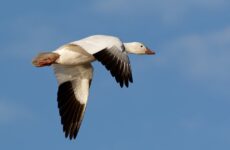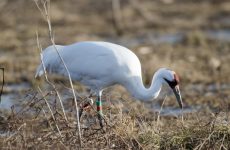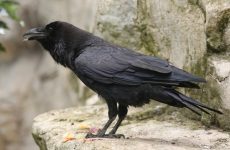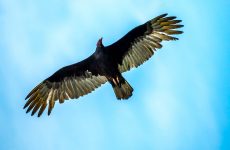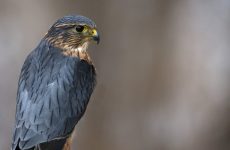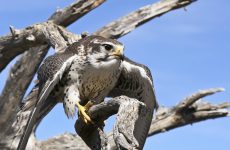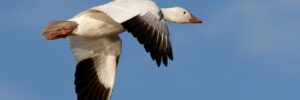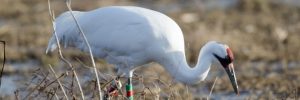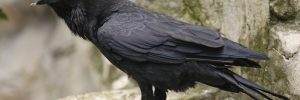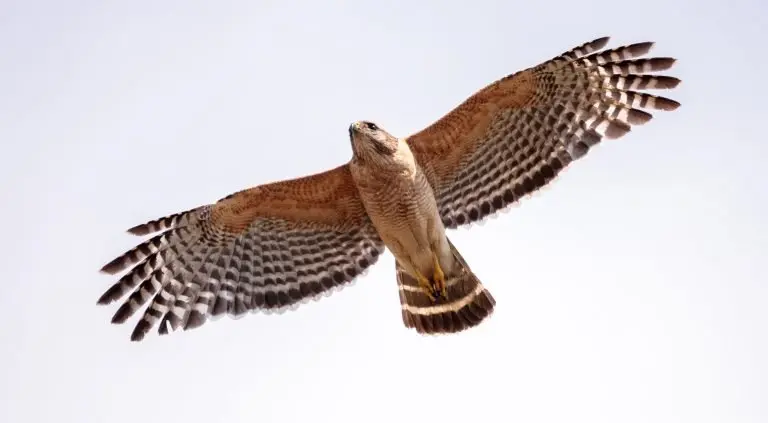
Do you know your Sharp-shinned Hawk from your Coopers Hawk or what hawks you can see in Maryland well read on to find out all that and more?
There are 7 species of Hawk in Kentucky:
- Sharp-shinned Hawk
- Cooper’s Hawk
- Red-shouldered Hawk
- Broad-winged Hawk
- Red-tailed Hawk
- Rough-legged Hawk
- Northern Harrier
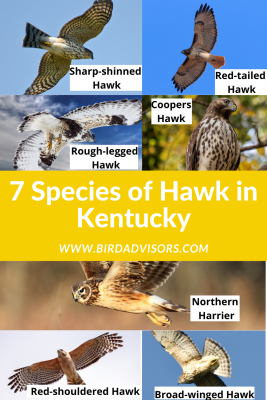
Did you know the largest hawks in Kentucky are the Rough-legged Hawk and the smallest hawks in Kentucky are the Sharp-shinned Hawk? Also, the most common hawk in Kentucky is the Red-tailed Hawk.
Hawks are birds of prey and hunt and eat birds and small mammals as well as snakes and frogs. Hawks can see in ultraviolet, which helps them hunt down their prey.
To find Hawks in Kentucky head to woodland for the smaller hawks such as the Sharp-shinned Hawk and Cooper’s Hawk or open grassland, marshes, or high ridges for the larger species.
If you enjoy finding out about birds of prey in Kentucky then you should check out all the eagles and vultures you can spot here.
Why don’t you also check out all the backyard birds in Kentucky and get a free ID printable checklist?
The 7 Species of Hawk in Kentucky
1. Sharp-shinned Hawk
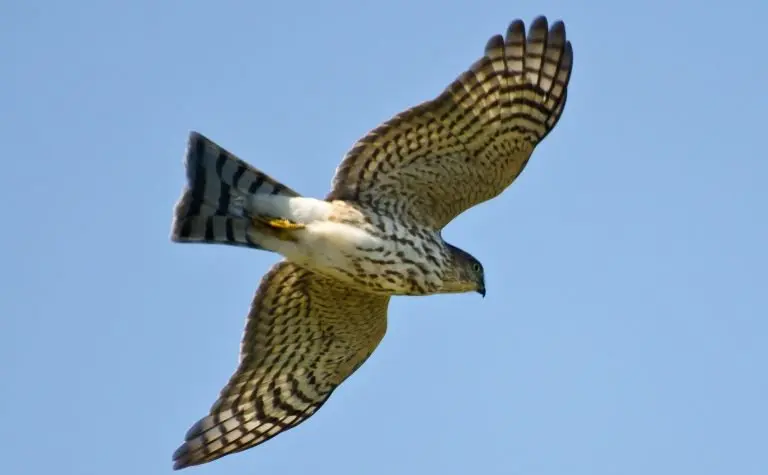
The Sharp-shinned Hawk is migratory and can be seen in winter in Kentucky. Some birds may stay all year in the east of the state. They are not very common and are in 1% of bird sightings in Kentucky.
The Sharp-shinned Hawk is the smallest hawk in Kentucky. They are smaller than a crow but slightly larger than a Jay.
The females are a third bigger than the male. They have long tails, with a square end, and short, rounded wings and have small heads.
- Length: 9.4-13.4 in (24-34 cm)
- Weight: 3.1-7.7 oz (87-218 g)
- Wingspan: 16.9-22.1 in (43-56 cm)
Adult Sharp-shinned Hawks are blue-gray across the back and have a red-orange breast. They have dark bands across their tails.
They are very secretive but can be seen as they fly across open areas at the edges of forests. They are very agile and can speed through dense woods to catch their prey in flight, usually songbirds.
They can sometimes be seen near feeders catching small birds, but if you have problems with them in your backyard remove the feeder for a few weeks.
Sharp-shinned Hawks pluck their prey on a stump or low branch before eating it. They usually eat songbirds about the size of a robin.
Nests of the Sharp-shinned Hawk are often in conifer trees in dense cover, usually towards the top of tall trees. The nest is quite large being 1-2 feet in diameter and 4-6 inches deep. They lay 3-8 white or pale-blue mottled eggs.
2. Cooper’s Hawk
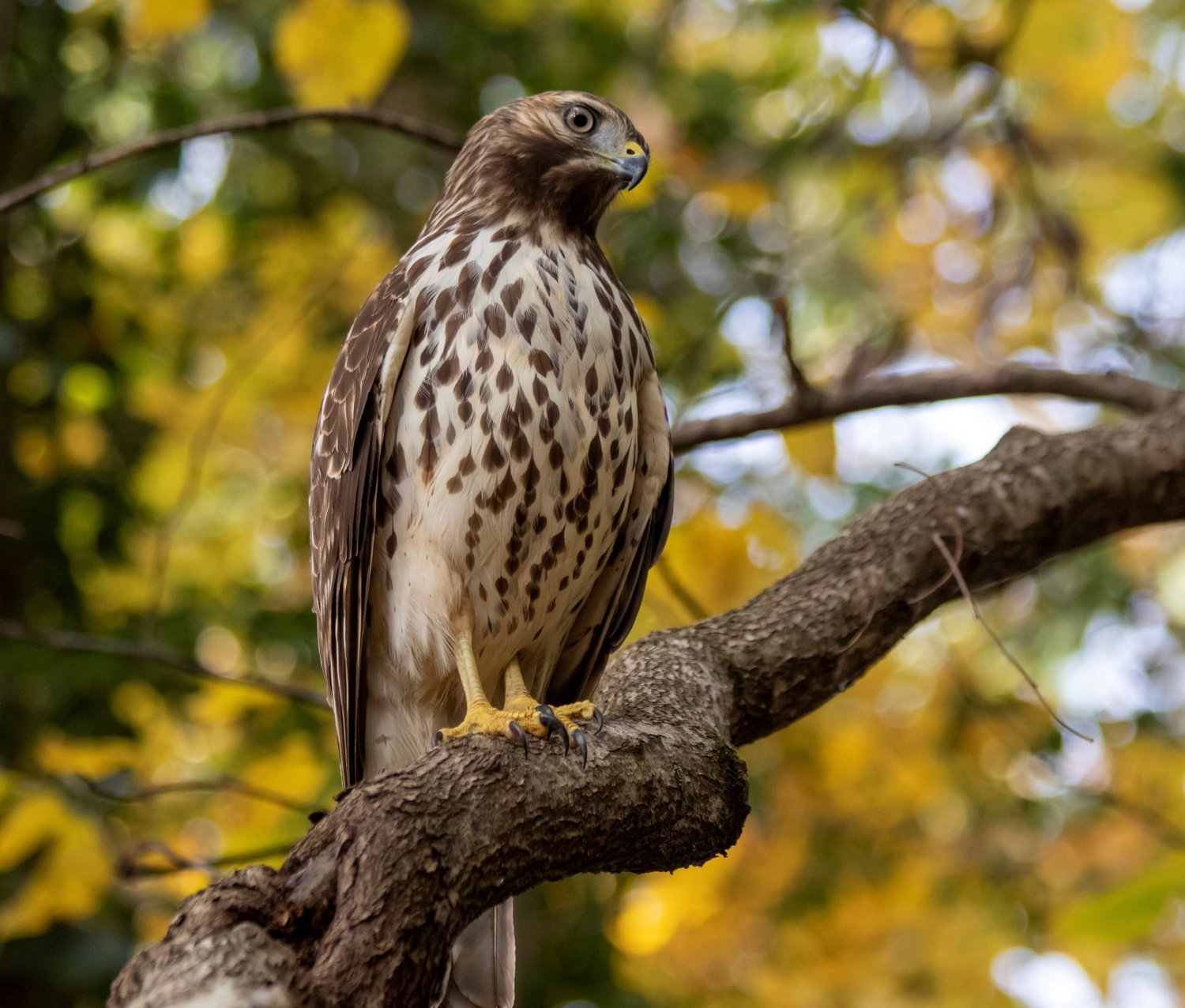
Cooper’s Hawks can be seen in winter in Kentucky. They are more common woodland hawks than the Sharp-shinned Hawk. They have been sighted in 6% of checklists in Kentucky.
Look out for them at the edge of forests, but they can also be seen at feeders looking for an easy meal.
The Cooper’s Hawk looks very similar to the Sharp-shinned Hawk but is bigger at about the size of a crow. They can be hard to identify between them as they have the same blue-gray back and red-orange breast and also with dark bands on the tail. They have a larger head that projects well beyond the wings, unlike the Sharp-shinned Hawk.
Male
- Length: 14.6-15.3 in (37-39 cm)
- Weight: 7.8-14.5 oz (220-410 g)
- Wingspan: 24.4-35.4 in (62-90 cm)
Female
- Length: 16.5-17.7 in (42-45 cm)
- Weight: 11.6-24.0 oz (330-680 g)
- Wingspan: 29.5-35.4 in (75-90 cm)
They feed on medium-sized birds and small mammals and nest in tall trees, often on top of an old nest of a large bird or clump of mistletoe. They lay 2-6 pale blue to bluish-white eggs.
3. Red-shouldered Hawk

The Red-shouldered Hawk can be found all year in Kentucky. They tend to be seen near wet forests hunting along a stream or pond. Their prey is mammals and frogs or snakes.
Red-shouldered Hawks are distinctly marked, with dark and white checkered wings and reddish barring on the breast. They are medium-sized, between the size of a crow and a swan with a strongly banded tail. They make a loud cack-cack-cack-cack call.
- Length: 16.9-24.0 in (43-61 cm)
- Weight: 17.1-27.3 oz (486-774 g)
- Wingspan: 37.0-43.7 in (94-111 cm)
Nests are often reused each year in a broad-leaved tree near water. They lay 2-5 white or bluish eggs.
4. Broad-winged Hawk
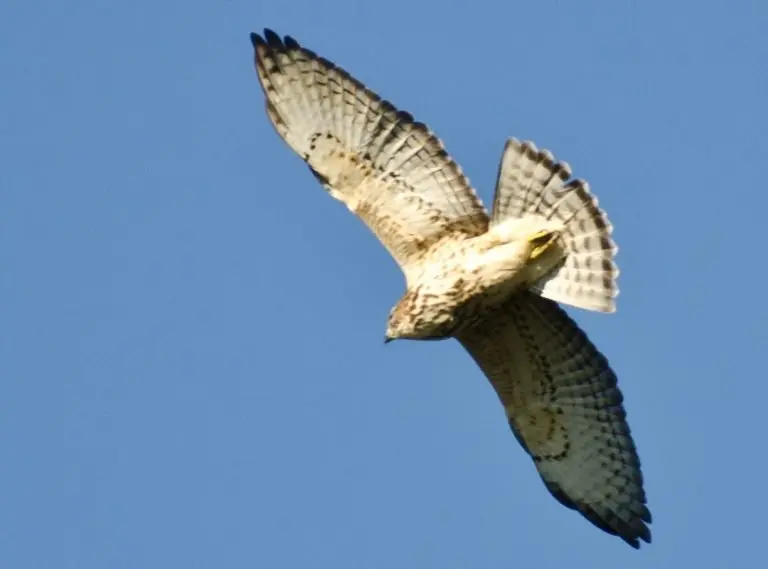
Broad-winged Hawks breed in Kentucky, before migrating in large numbers to South America in a swirling flock called a kettle. They breed more in the west of the state. They are not often observed in Kentucky, being in just 1% of recorded checklists on ebird.
The migration in fall is the best chance to see them.
The Broad-winged Hawk is a compact, stocky bird between the size of a crow and goose. They have reddish-brown heads, barred breasts, and narrowly banded short square tails.
- Length: 13.4-17.3 in (34-44 cm)
- Weight: 9.3-19.8 oz (265-560 g)
- Wingspan: 31.9-39.4 in (81-100 cm)
Hunting from a perch often on the edge of woods or by water, these hawks eat small mammals, frogs, snakes, and even young turtles.
The Broad-winged Hawk often reuses the nest of another animal, such as a crow or squirrel and lays 2-3 whitish eggs.
5. Red-tailed Hawks
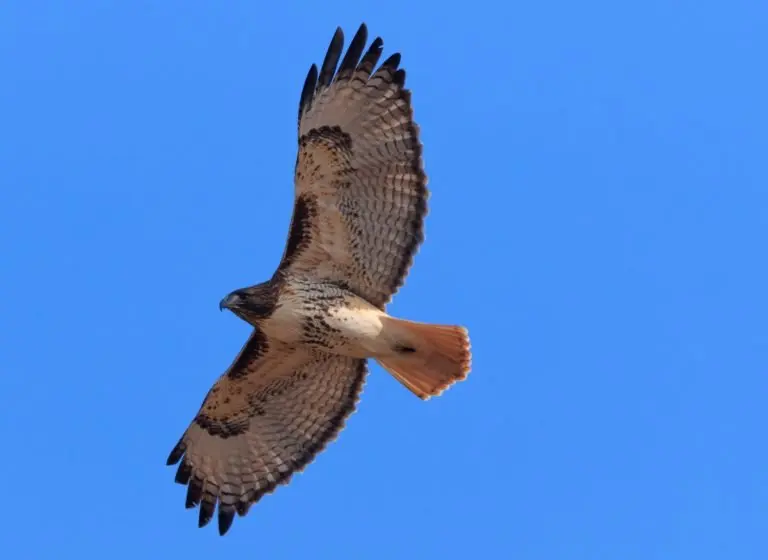
Red-tailed Hawks can be found in Kentucky all year and are common, being seen in 15% of sightings in Kentucky. They are also the easiest to spot, often on long car journeys, as they circle slowly over open fields looking for prey. You can also see them perched on telephone poles.
Male
- Length: 17.7-22.1 in (45-56 cm)
- Weight: 24.3-45.9 oz (690-1300 g)
- Wingspan: 44.9-52.4 in (114-133 cm)
Female
- Length: 19.7-25.6 in (50-65 cm)
- Weight: 31.8-51.5 oz (900-1460 g)
- Wingspan: 44.9-52.4 in (114-133 cm)
As their name suggests, the Red-tailed Hawk has a distinctive short, wide red tail. They are large, with broad, rounded wings, between the size of a crow and goose. Most Red-tailed Hawks are brown on the back and pale underneath.
The high-pitched descending raspy-screech sound of the Red-tailed Hawk is often used in movies for all raptors. They eat small mammals, birds, and reptiles.
Nests are high in very tall trees or on cliff ledges and sometimes on tall buildings or towers. They lay 2-3 whitish, brown blotched eggs.
6. Rough-legged Hawk
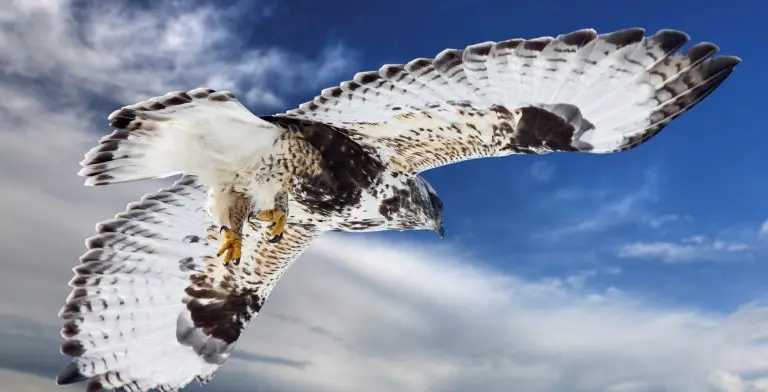
Rough-legged Hawks migrate from the arctic and are found in the state in winter, but not very often as this is the edge of their winter range. They are not very common in the state and are only seen in less than 1% of sightings in Kentucky.
Rough-legged Hawks are usually sighted hovering over marshes and open fields or perched on a pole.
- Length: 18.5-20.5 in (47-52 cm)
- Weight: 25.2-49.4 oz (715-1400 g)
- Wingspan: 52.0-54.3 in (132-138 cm)
The feathered legs give the Rough-legged Hawks their name and help to keep them warm in the arctic. They are fairly large hawks, between the size of a crow and a goose.
This predominantly dark-drown species occurs in both light and dark forms, with dark patches at the bend of the wing, end of their tails, and across the belly. They have broad wings that are fairly long and narrow, compared to other hawks.
Lemmings and voles provide most of the prey for Rough-legged Hawks. Voles, mice, ground squirrels, and other small mammals provide winter prey in states such as Kentucky. Nests are usually on a high cliff ledge and they lay 3-5 pale bluish-white eggs.
7. Northern Harrier
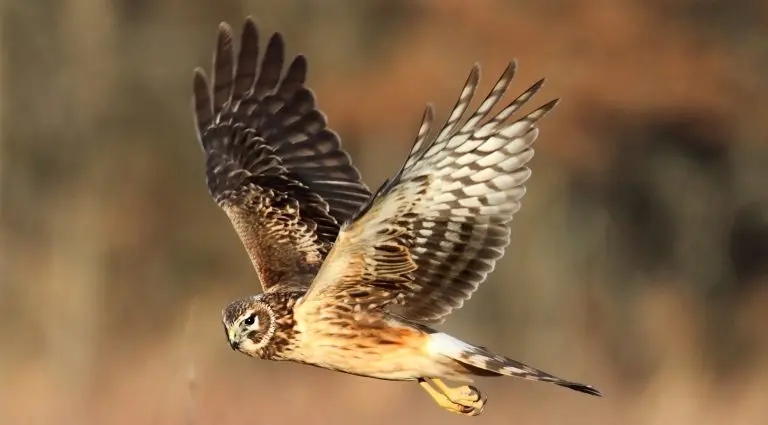
The Northern Harrier is in Kentucky in the winter after breading in Canada and northern states. This slim, longed-tailed Hawk can be seen gliding low over grassland or marshes. They are spotted in 2% recorded checklists on ebird.
- Length: 18.1-19.7 in (46-50 cm)
- Weight: 10.6-26.5 oz (300-750 g)
- Wingspan: 40.2-46.5 in (102-118 cm)
These hawks are slender with long broad wings and are between the size of a crow and goose. They often fly with the tips of their wings higher than their bodies in a v-shape. Females are brown and males are gray above and white below and they have a white rump patch.
Northern Harriers mostly eat small mammals and small birds. They nest on the ground in dense vegetation such as reeds, willows, or brushtails. They lay 4-5 dull white eggs.

